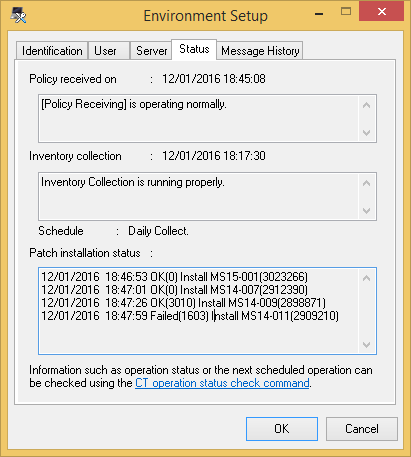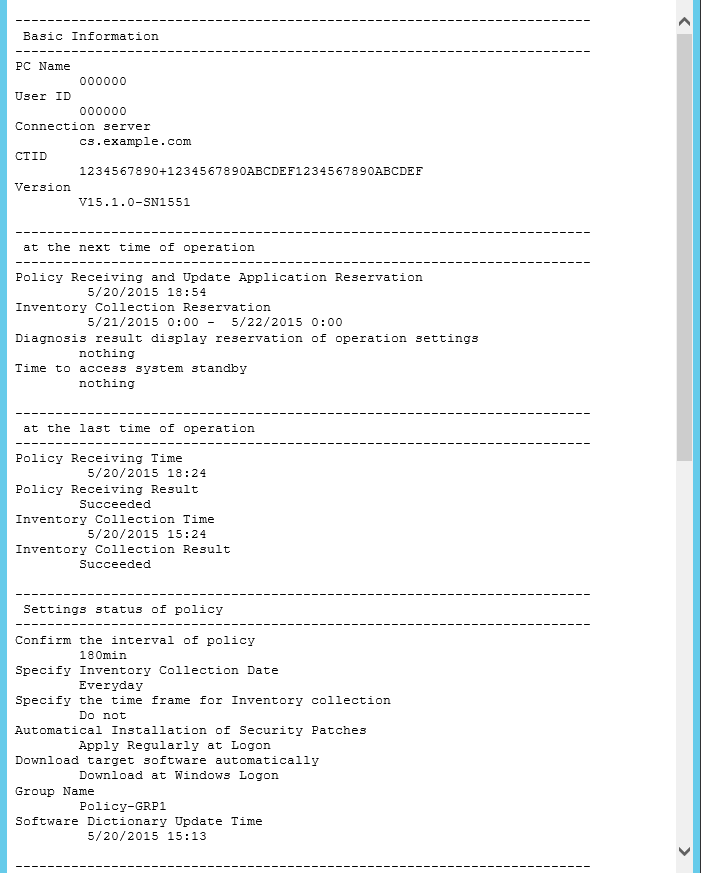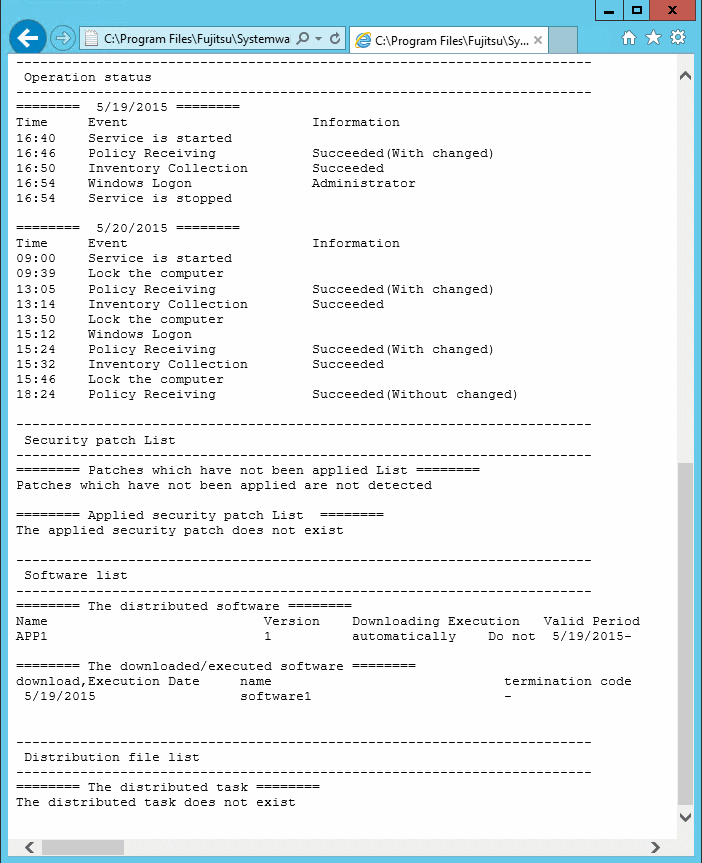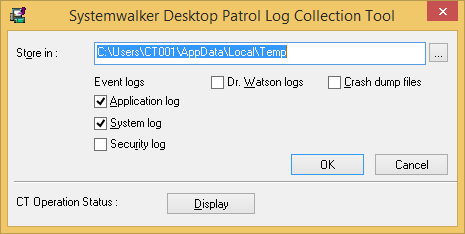This section describes how to confirm whether the CT run according to the policy set in the main menu.
The operation status on CS or CT can be confirmed.
When using in the following timing, the operation status of CT can be confirmed.
When operation is started or modified
During the installation of Systemwalker Desktop Patrol or when settings are modified, use it to confirm whether the policy set in the main menu is correct or not.
For example, use in the following timing.
When Systemwalker Desktop Patrol is installed for the first time
When version update of Systemwalker Desktop Patrol is performed
When the structure of system is modified
When the setting of policy is modified
When trouble occurs
Use it when trouble occurs on CT or to confirm whether trouble has occurred.
Security patch is not installed
Inventory information is not notified to server (CS/DS)
The software reserved for distribution is not distributed
When checking the operation status on CT, use one of the following methods.
Execute the logcheck.exe (check CT operation status) command
Start from the logget.exe (log collection tool) command
Execute the logcheck.exe (check CT operation status) command
Execute the following command.
Installation directory of CT\FJSVsbtrsc\bin\logcheck.exe |
For details of the logcheck.exe (check CT operation status) command, refer to Reference Manual.
Point
logcheck.exe (check CT operating status on CS) can also be executed by clicking the link in CT operation status check command in the Status tab in the Environment Setup window.

Start Web browser, the operation status of CT will be displayed.


Category | Item | Description | Displayed Content | |
|---|---|---|---|---|
logcheck | logcheckcs | |||
Basic Information | Collection Time | Display the time when inventory is collected. | Y | |
PC Name | Display the value set in environment setup. | Y | Y | |
User ID | Y | Y | ||
Collection Server | Y | Y | ||
CTID | Display CTID. This information is the value obtained in internal processing at CT installation. | Y | Y | |
Version | Display the version of CT. Example: V14.1.0-R1.0-SN950 Example: Version prior to V12 | Y | Y | |
at the next time of operation | Policy Receiving and Update Application Reservation | Display the time of next policy receiving or updater application. | Y | |
Inventory Collection Reservation | Display the time to perform next inventory collection. | Y | ||
Diagnosis result display reservation of operation settings | Display the time when the diagnosis result of operation setting is displayed next time. | Y | ||
Time to access system standby | Display the time when shifting to system standby next time. | Y | ||
at the last time of operation | Policy Receiving Time | Display the time when policy has been received last time. | Y | |
Policy Receiving Result | Display the result after last policy receiving. | Y | ||
Inventory Collection Time | Display the time when inventory collection is performed last time. | Y | ||
Inventory Collection Result | Display the result after last inventory collection. | Y | ||
Settings status of policy | Confirm the Interval of Policy | Display the policy information set in Environment Setup > Policy Groups in the main menu. | Y | Y |
Specify Inventory Collection Date | ||||
Specify the time frame of Inventory collection | ||||
Automatical Installation of Security Patches | ||||
Downloaded target software automatically | ||||
Group Name | ||||
Software Dictionary Update Time | ||||
Operation status | - | CS: Display the latest operation status of CT of the last two days. CT: Display the latest operation status of CT of the last 7 days. (display the part of date number of the date when PC was started) In case of CS, through specifying operation, all operation status kept in CS can be displayed. For displayed item, refer to Table 3.10 [Displayed Item of Operation Status] of the following table | Y | Y |
Security patch List | Patches which have not been applied List | Display the list of security patches to be installed to the target CT. | Y | Y |
Applied security patch List | Display the list of security patches that have been installed to the target CT. | Y | ||
Software list | The distributed software | Display the list of software that has been distributed to the target CT. | Y | Y |
The downloaded/executed software | Display the list of software that has been downloaded and executed in the target CT. | Y | ||
Distribution file list | The distributed task | Display the list of distribution result of distribution task of file distribution. | Y | Y |
Y: content will be displayed.
Item | Details | Description |
|---|---|---|
Shift to System Standby | - | Shifted to standby. |
Restore from System Standby | - | Restored from standby. |
Windows Logon | <Logon Account of Windows> | user has logged on. |
Windows Logoff | <Logon Account of Windows> | user has logged off. |
Switch of Users | <Logon Account of Windows> | user has been switched. |
Lock of Computer | - | It has been locked. |
Connect to Network | - | It is connected to network and communication is enabled. |
Cut off Network | - | The network is cut off and communication is disabled. |
Start Service | - | ITBudgetMGR(INV) service has been started. |
Stop Service | - | ITBudgetMGR(INV) has been stopped. |
Policy Receiving | Successful (with change) Successful (without change) Failed (<Error Code> <Description>) Example) Failed (10051 Unable to connect to the connection server) | Policy has been received. |
Inventory Collection | Successful Failed (<Error Code> <Description>) Example) Failed (10051 Unable to connect to the connection server) | Inventory has been collected. |
Patch Installation | Successful (<Name>, End Code(<n>)) Failed (<Name>, End Code(<n>), <Description>) Example 1) Successful (Install MS09-048 Critical(967723) to WindowsVista/SP1/SP2, End Code(0)) Example 2) Failed (Install MS09-048 Critical(967723) to WindowsVista/SP1/SP2, End Code(-3), Fatal error occurred during installation.) | Patch has been installed. For details of end code of patch, refer to the Reference Manual. |
Software Download | <Name> ver.<n> has been downloaded Failed to download <Name> ver.<n> (<Error Code><Description>) <Name> ver.<n> has been executed, End Code<m> Example 1) Information sending tool ver.2 has been downloaded Example 2) Failed to download information sending tool ver.2 (10051 Unable to connect to the connection server) Example 3) Failed to execute information sending tool ver.2 Failed (-13 authority pretending failed) Example 4) Information sending tool ver.2 has been executed, End Code 0 | Software has been downloaded. |
Restart Automatically | After patch has been installed, restart has been performed automatically After patch installation, restart has been performed according to user operation. | After patch installation, restart has been performed. This item is displayed when performing patch installation in Systemwalker Desktop Patrol and restart is selected. In usual operation of Windows, it is not displayed when restart is performed. |
Start Updater Application | Before application (V15.1-SN2010) and after application (V15.1-SN2035) | Start applying the updater. |
Point
Location for saving the files displayed in the window (when executed on CT)
Folder: Installation Directory of CT\FJSVsbtrsc\data\status
File: ctstatus.txt (*)
*: File is output in UTF-8 format.
Start from the logget.exe (log collection tool) command
Execute the logget.exe (log collection tool) command, and the Systemwalker Desktop Patrol Log Collection Tool dialog will be displayed.

Click the Display button in this dialog.
For the logget.exe(log collection tool) command, refer to Reference Manual.
Start Web browser, and the operation status of CT will be displayed.
The displayed window and items are the same as "Execute the logcheck.exe (check CT operation status) command".
When checking the operation status of CT on CS, perform through executing the logcheckcs.exe.
For details of logcheckcs.exe (Check the Operation Status of CT on CS), refer to Reference Manual.
Log on to Windows with the user that belongs to the Administrators group.
Execute the command operation for the CT to be confirmed. There are following methods to specify the option
The method that specifies part of the string of user ID, PC name, connection server as the search condition (partial match)
The method that specifies the user ID, PC name, connection server (complete match)
The method that specifies part of the string of user ID, PC name, connection server as the search condition
Start the following command.
Installation Directory of CS\FJSVsbtrs\bin\logcheckcs.exe <Search string> |
For example, when searching the CT that contains "yama", start the following command.
Installation Directory of CS\FJSVsbtrs\bin\logcheckcs.exe yama |
The CT whose user ID and PC name and connection server matches with the entered search string in a list.
When only one target CT exists in the searched result, Web browser will be started after the list has been displayed and the operation status of CT will be displayed.
No User ID PC Name Connection Server |
Enter the No. of CT to be confirmed, and Web browser will be started and the operation status of CT will be displayed.
For the displayed window and displayed item, refer to the item marked as "Y" in the "logcheckcs" column of Displayed Content of Displayed Items that can be Confirmed in the Window recorded in "Execute the logcheck.exe (check CT operation status) command".
The method that specifies the user ID, PC name, connection server
When it is difficult to narrow down the CT by string search, and the user ID, PC name and connection server are unknown, execute the following command to specify CT.
Installation Directory of CSFJSVsbtrsbinlogcheckcs.exe [-u User ID] [-p PC Name] [-s Connection Server] |
Example 1) When user ID is "User", PC name is "PC" and connection server is "ds.example.com", start the following command.
Installation Directory of CSFJSVsbtrsbinlogcheckcs.exe -u User -p PC -s ds.example.com |
Example 2) When PC name and connection server are omitted, start the following command.
Installation Directory of CS\FJSVsbtrs\bin\logcheckcs.exe -u User |
When the CT whose user ID, PC name and connection server are matched with the specified option exists, it will be displayed in the list.
When there is only 1 CT in the searched result, Web browser will be started after the list has been displayed, and the CT operations status will be displayed.
No User ID PC Name Connection Server |
Enter the No. of CT to be confirmed, and Web browser will be started and the operation status of CT will be displayed.
For the displayed window and displayed item, refer to the item marked as "Y" in the "logcheckcs" column of Displayed Content of Displayed Items that can be Confirmed in the Window recorded in "Execute the logcheck.exe (check CT operation status) command".
Note
About displayed information
For displayed message, even if CT is uninstalled, the information before CT uninstallation will be kept on CS. Therefore, when Ct is installed again and the user ID, PC name and connection server that are same as before is set, the information displayed CS is still the information before uninstallation.
Point
About display of operation status
When there is no particular specification, the operation status of the latest two days will be displayed. However, through specifying the "-a" option, all operation status kept in CS will be displayed.
Installation Directory of CS\FJSVsbtrs\bin\logcheckcs.exe [-a] <Search string> Installation Directory of CS\FJSVsbtrs\bin\logcheckcs.exe [-a] [-u User ID] [-p PC Name] [-s Connection Server] |
Under the environment in which the CT operation status log is not collected, "Operation Status" will not be displayed. By using the CTPolicy.exe (client environment setup) command, collection function of CT operation status log can be enabled/disabled.
Location for saving the files displayed in window (when executed on CS)
Folder: Installation Directory of CS\FJSVsbtrs\data\ctstatus
File: <User ID>+<PC Name>+<Connection Server>.txt (*)
(*) File is output in UTF-8 format.